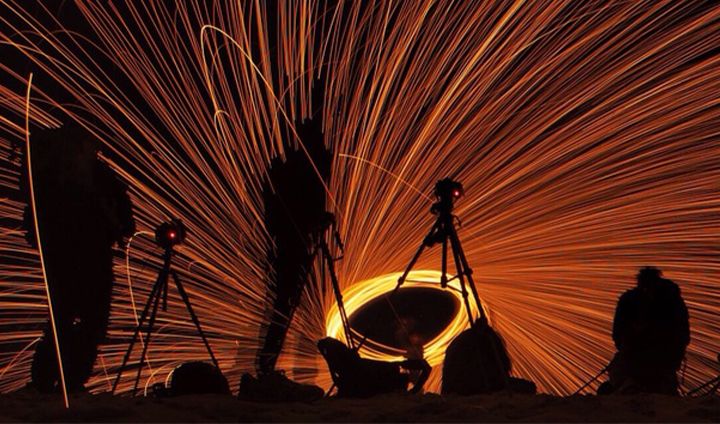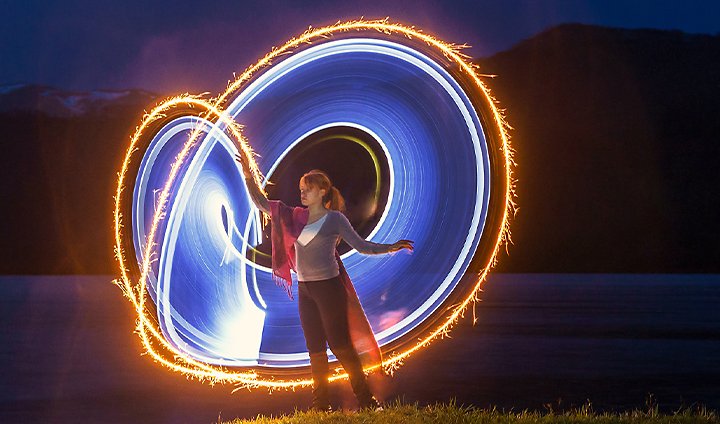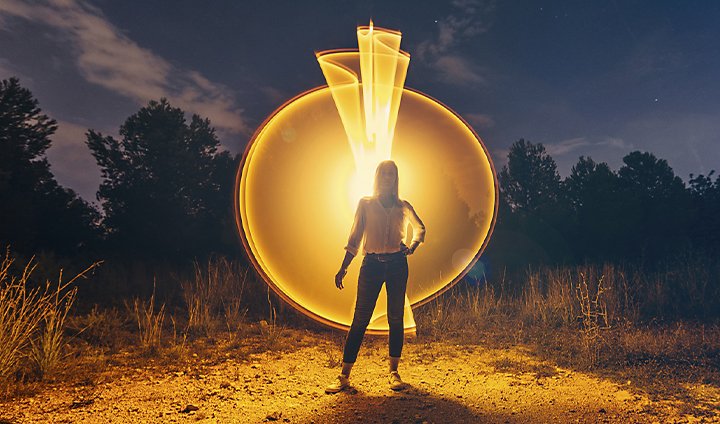Photography (20GB)
Rp149.628/mo
Lightroom on desktop and mobile, Lightroom Classic, and Photoshop on desktop and iPad. Learn more
With the right camera settings, photographers can turn moving lights into bright, dynamic images. Learn the basics of how to light paint so you can create glowing images using motion and longer exposure times.

What is light painting?
Light painting is the art of creating photos by setting long exposure times on a camera and using a moving light source to “paint.”
A light painting photographer opens a camera’s shutter, and keeps it open, as they draw in the air with a light source. The finished product is an image of that light source’s path: lines of light through darkness, creating a glowing image in the open lens during the long exposure time. “It’s long exposure photography,” says light painter Kris Foot. “You’re opening the shutter for a longer period of time, and using either lights that are already there or controlling your own lights.”
Sometimes light painting photography takes advantage of preexisting light sources. It’s possible to open a shutter as stars and planets trace paths across the sky or as car headlights streak down a highway. Some of the most memorable types of light painting rely on light sources produced by the artist. Using a flashlight, illuminated tube, or flame, artists can paint nearly anything with light. It’s just a matter of precision, patience, and creativity.
The technical side of light painting.
Light paintings are long exposure photographs. To be a truly effective light painter, you need to understand how the camera works and how to control different parts of what photographers call the exposure triangle: shutter speed, aperture, and ISO.


Camera presets are generally not made with light painting in mind. Successful light photographers have to learn how to shoot in manual mode and exert fine-grain control over their settings. “Learning how to shoot in manual is key,” says light painter Andrew Chin. “When you understand your exposure triangle, you will understand how the light is being affected and how each of your settings affects the end image.”
Getting the shot you want involves more than just knowing your camera settings and exposure time. Light painting takes planning and practice. You must have an eye for ambient light and know how the environment is going to affect your shot.
It’s possible to do light painting in a dark indoor setting. However, many light painters want to juxtapose their illuminated images with the natural world or outdoor environment. If you’re going to shoot outside, you need to plan carefully. “Time of day is very key in your light painting,” says Chin. “You probably want to start shooting in the blue hour. That’s when it starts getting dark enough for you to start painting with light.”
Blue hour is the time just after sunset when there’s still some sunlight and the sky takes on a blue or purple hue. It’s a well-loved time for photographers because it offers the atmospherics of night photography, but with some natural light in the sky so details of the scene aren’t yet covered in darkness. Blue hour is a great time for light painting, provided you keep track of the ambient light.

“Unlike photography where normally the light is consistent throughout your shoot, if you shoot at blue hour, that light changes five or ten minutes at a time” says Chin. Plan ahead, have a sense of how long remaining sunlight will last, and time your shoot so that ambient light is more or less consistent during the time frame when you have your aperture open.
It’s also possible to wait until sunlight has faded from the sky entirely. Shooting in the dark of night usually means there’s less to keep track of, but blue hour will allow for more to be captured in your scene alongside your light painting.
Gear for light painters goes beyond photography tools, and ventures into the realm of art supplies. Just like a painter needs brushes and a canvas, a light painter needs equipment that keeps the camera still and light sources that trace illumination through the dark.

For advanced light painters, fire is also popular, and spinning flaming steel wool for your shots can yield dramatic results. Be advised, painting with fire can be very dangerous, so follow all local laws and guidelines in your area.
Ultimately, the most important technique for light painting is self-expression. Light painting can mean drawing floating orbs of light in the air or sketching figures with light drawing. It’s emulating street art with light graffiti and enhancing fashion shoots with impossible images of glowing motion. Find the photographic techniques and light sources that work for you, and create the images that inspire you.
Create beautiful images with Photoshop brushes, Content-Aware Fill, Photo effects, Neural Filter, Sky replacement, and the many tools photographers rely on.
Explore the Photoshop family of apps.
Discover how adjusting shutter speed can help you capture clean shots or motion-filled moments.
Night Photography.
Low light doesn’t have to equal low quality with these tips for successful nighttime photos.
The world of double exposure photography.
Explore double exposure photography and learn how to create one yourself.
Tips for capturing nature photos of all kinds.
Explore the possibilities of nature photography, from animals in motion to sprawling landscapes.
Edit, organize, store, and share photos from anywhere.
7 days free, then inclusive of VAT
Get Lightroom, Lightroom Classic, Photoshop, and 20GB of cloud storage. 7 days free, then inclusive of VAT
Get the entire collection of creative apps and more.
7 days free, then inclusive of VAT
Find the Creative Cloud plan that’s right for you.
Rp149.628/mo
Lightroom on desktop and mobile, Lightroom Classic, and Photoshop on desktop and iPad. Learn more
Photography (20GB)
Lightroom on desktop and mobile, Lightroom Classic, and Photoshop on desktop and iPad. Learn more
Rp149.628/mo
Rp344.322/mo
Get Photoshop on desktop and iPad as part of Creative Cloud. Learn more
Adobe Photoshop Single App
Get Photoshop on desktop and iPad as part of Creative Cloud. Learn more
Rp344.322/mo
Rp868.686/mo
Get Photoshop on desktop and iPad, plus the entire collection of creative apps. Learn more
All Apps
Get Photoshop on desktop and iPad, plus the entire collection of creative apps. Learn more
Rp868.686/mo
Rp299.478/mo.
Save over 60% on the entire collection of Creative Cloud apps. Learn more
Students and teachers
Save over 60% on the entire collection of Creative Cloud apps. Learn more
Rp299.478/mo